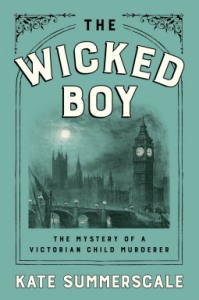 Non-Fiction
Non-Fiction5*s
I do love Victorian true crime and Kate Summerscale managed to stumble across a fairly obscure one in 1895 West Ham, that of a young boy, thirteen year old Robert Coombes who was accused of murder and stood trial at the Old Bailey on just that charge.
The beauty of Kate Summerscale’s books are the minutiae of detail that surround the actual substance of the book, and this one is no different. The crime in this instance isn’t the puzzle that we met in The Suspicions of Mr Whicher, rather this is a book about the attitudes of the day both in the media and those in the legal profession. It also looks at the contemporary view of the medical profession on inherent wickedness including a fairly popular one that considered children little more than wild animals to be tamed.
Robert and his younger brother Nattie Coombes had gone to watch the cricket at Lords in the aftermath of the murder as well as going to the seaside and playing in the vicinity of their home. However as the accused they could not defend themselves in court:
The law barred defendants from testifying, but since Fox, Robert and Nattie had no legal representation they were entitled to question the witnesses that Baggallay called.
Can you imagine boys of thirteen and twelve who had never been in court before having the wherewithal to question witnesses that accused them of murder? I can’t!
The media was less concerned with this fundamental flaw in the proceedings and were instead highly concerned in the ‘penny bloods’ that Robert devoured. When one journalist at St James’s Gazette was tasked with reading the publications he stated the following:
The task was ‘repulsive and depressing’, he said; the writing ‘brutalised my whole consciousness’, reviving ‘the fundamental instinct of savagery inherent in us all It disgusts, but it attracts; as one reads on the disgust lessens and the attraction increases. ‘The Coombes boys, he concluded, ‘with their intelligence scientifically developed at the expense of the ratepayers, had been wound up to regard murder as a highly superior kind of ‘lark’ by a sedulous study of the worst kind of gory fiction and cut-throat newspaper’.
This of course was one of the first generations of children who had been educated at the Board Schools set up in each district. It seems from this piece that there was a general feeling that this money was wasted on the poorer members of society. The biggest concern however was around the number of the publications of penny bloods that were found in Robert and Nattie’s home, their influence was considered by some as the chief catalyst in the murder – not so very different to our own newspapers in recent years lamenting various films and games that were also a big attraction to teenage boys. In fact there were a number of media reports in this book that could quite easily be transported to today’s press with only minor alterations needed to update them!
This book isn’t just about the murder and the trial though it goes on to follow Robert through his life to see what life for a child murderer looked like in Victorian England. The answer may not be quite what you expect! All through this time Kate Summerscale draws comparisons to other happenings of the day, other crimes that filled the courts, the life of those who lived in the same area as the Coombes boys. Nuggets of priceless information abound the pages with subjects quite wide-ranging while always linked the central story but give lovers of historical facts like me a treasure chest of facts to wonder upon.
Each male patient was allocated an ounce of tobacco a week, drawn from the government stock of contraband seized by Customs & Exercise officer.
With so much to absorb, particularly as my maternal ancestors moved to West Ham around the turn of the Twentieth century and in particular one of the newspaper reports featured in this look at crimes at this time involved distant relatives of mine, there was much to keep me entertained and engaged from beginning to end. The End notes are a delight all of their own:
The sun rose at 3:53 a.m. that morning according to the London Standard of 8 July 1895 and set at 8:15 p.m. The Standard of 9 July reported that the temperature on Monday rose to 81 degrees Fahrenheit in the shade.
leaving me in no doubt at all regarding the quality of the research undertaken by Kate Summerscale.
I am very grateful for the publishers Penguin Press for allowing me to read a copy of The Wicked Boy ahead of publication on 5 May 2016 although I’m equally excited to receive my own copy which is on pre-order so I can cross reference the end notes side by side with the main chapters for ease. This review is my own, unbiased opinion.
Other Books by Kate Summerscale
The Suspicions of Mr Whicher
Mrs Robinson’s Disgrace


